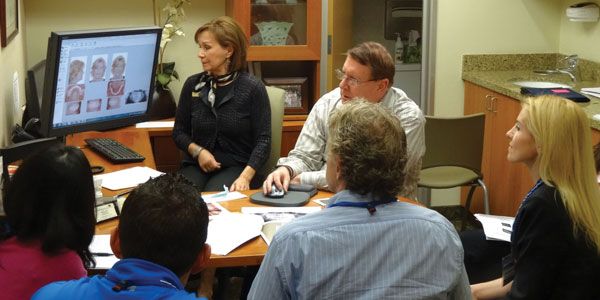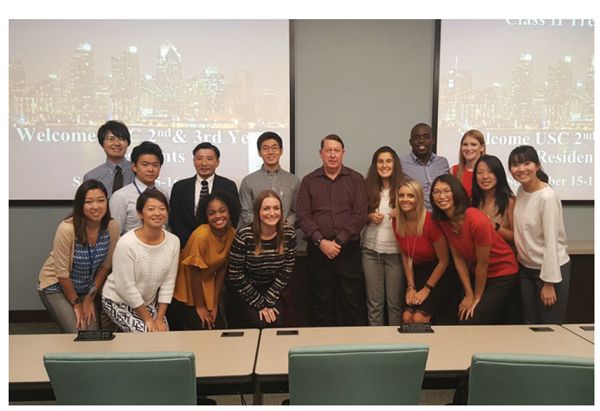Dr. Richard P. McLaughlin discusses current trends in orthodontics

What do you think will be the next big trend in orthodontics?

Orthodontics is always evolving, and there are some exciting trends.
CBCT imaging and digital models —CBCT imaging is a great help for accurately locating impacted tooth positions, as well as the evaluation of temporomandibular joint and airway issues. It is helpful in locating the correct location for TAD and plate positioning. It is also becoming a most exciting area in the diagnosis and treatment planning of surgical orthodontic cases, and for allowing this information to be shared by the orthodontist and surgeon. Intraoral scanning of the dentition is becoming a very accurate method of creating study models and removable appliances and using them for a variety of applications, just as we have done with study models in the past. It is a great timesaver in this area (for example, in the area of indirect bonding) and will work well in many special situations.
TADS and plate technology — TADS and plates have been used in orthodontics for some time. The need for, the location of, and the percentage of failure of these devices continues to be an issue. However, when these issues are worked through, TADS and plates become a very effective method of controlling anchorage and moving teeth in ways that were previously very difficult or impossible. Much improved control of the vertical dimension can be achieved with these devices.
How has the use of aligners changed orthodontics?
The development of the aligner concept and all of the marketing being done has resulted in more individuals presenting for orthodontic evaluations. In this way, it has created a greater interest in orthodontic treatment. Aligner treatment is a good option for those patients who have a good posterior occlusion and malalignment of their front teeth. In this situation, aligners allow for effective control of posterior teeth, while improving the position of the anterior teeth. Since they are generally less effective in moving posterior teeth than fixed orthodontic appliances, there can be compromises in the overall treatment result. It is beneficial to explain to patients that occasionally it is beneficial to have a short phase of fixed orthodontic appliances, after the aligners, to fully correct some malalignment difficulties. So, overall with the significant variations in malocclusions that present, a differential diagnosis is critical in determining whether aligners of fixed appliances are the best choice for treatment.
On bracket manufacturing, what have you learned over the years, and what do you feel is necessary to make an ideal bracket?
From an orthodontic standpoint, the most important part of the bracket is the interaction between the bracket slot and the archwire. With the edgewise appliance, the initial bracket slot used was .022. As treatment proceeded, a rectangular wire was used for the major tooth movements. The wire sizes ranged from .017 x .025, .018 x .025, .019 x .025, or .021 x 025. A slot size bracket .018 was later added with the edgewise appliance. The major archwires used with this appliance were the .016 x .022 and .017 x .025. Edgewise brackets were machine milled. Archwires were adjusted for three-dimensional movements: tip, torque, and in-out dimension.

Andrews created a significant change in orthodontic appliances by developing the Straight Wire Appliance™. Tip, torque, and in-out dimension were built into each bracket. Archwires were shaped to fit the arch form without the above wire bending. This significantly reduced the time spent with each patient. The “straight-wire” brackets were cast in stainless steel, much like gold crowns. In time, other variations of straight wire appliances were developed.
In the mid to late 1980s, most companies made brackets using a technique called metal injecting molding (MIM). Powdered stainless steel was heated to a high temperature and then was poured into the molds for each bracket. The metal cooled in the mold, and there was a slight amount of shrinkage during this process. To prevent brackets from being undersized during the shrinkage process, tolerances above the size of the traditional .022 and .018 slot sizes were used. Archwires were developed with varying sizes and varying amounts of contour on their edges. The brackets were still sold as .022 and .018 sizes, despite the variations in the slot size.
More recently, brackets were made with accurate milling machines out of bars of solid metal. The technique was referred to computer numerical control (CNC), and the brackets were closer to the .022 and .018 dimensions. They also had a greater stiffness than the MIM brackets. Adjustments in technique were required with the CNC bracket system, as opposed to the more frequently used MIM bracket system. The choice that is selected by the orthodontist requires awareness of this important difference.
What advice would you give the current graduating orthodontic residents concerning how they should approach their career in orthodontics?
I always recommend that young orthodontists set goals to continue to improve on the quality and efficiency of their treatment. Developing a systematic approach to every aspect of diagnosis, treatment planning, and treatment mechanics is most helpful. Educating your staff to implement this process is essential. Participating in orthodontic study clubs and interdisciplinary study groups will keep you current, and state-of-the-art thinking is very advantageous. All the above factors are important in developing a successful practice. Lastly, enjoy the opportunity to create stable occlusions, beautiful smiles, and improve the quality of life for so many people. Orthodontics is a wonderful career!

Stay Relevant With Orthodontic Practice US
Join our email list for CE courses and webinars, articles and mores

 Richard P. McLaughlin, DDS, completed his orthodontic training at the University of Southern California in 1976. Since then he has been in full-time orthodontic practice in San Diego, California. He has lectured extensively in the United States as well as internationally. He is a member of the Pacific Coast Society of Orthodontists, the American Association of Orthodontists, and a Diplomate of the American Board of Orthodontics. He is the Past Component Director of the Southern California Component of the Edward H. Angle Society of Orthodontists and Past President of the National Angle Society. He is the recipient of the 2009 American Board of Orthodontics Dale Wade Award as well as the 2010 Pacific Coast Society of Orthodontists Award of Merit. In addition, Dr. McLaughlin is a clinical professor at the University of Southern California, Department of Orthodontics in Los Angeles, California, and an associate professor at Saint Louis University, Department of Orthodontics. He has written more than 30 journal articles and co-authored five textbooks.
Richard P. McLaughlin, DDS, completed his orthodontic training at the University of Southern California in 1976. Since then he has been in full-time orthodontic practice in San Diego, California. He has lectured extensively in the United States as well as internationally. He is a member of the Pacific Coast Society of Orthodontists, the American Association of Orthodontists, and a Diplomate of the American Board of Orthodontics. He is the Past Component Director of the Southern California Component of the Edward H. Angle Society of Orthodontists and Past President of the National Angle Society. He is the recipient of the 2009 American Board of Orthodontics Dale Wade Award as well as the 2010 Pacific Coast Society of Orthodontists Award of Merit. In addition, Dr. McLaughlin is a clinical professor at the University of Southern California, Department of Orthodontics in Los Angeles, California, and an associate professor at Saint Louis University, Department of Orthodontics. He has written more than 30 journal articles and co-authored five textbooks.
